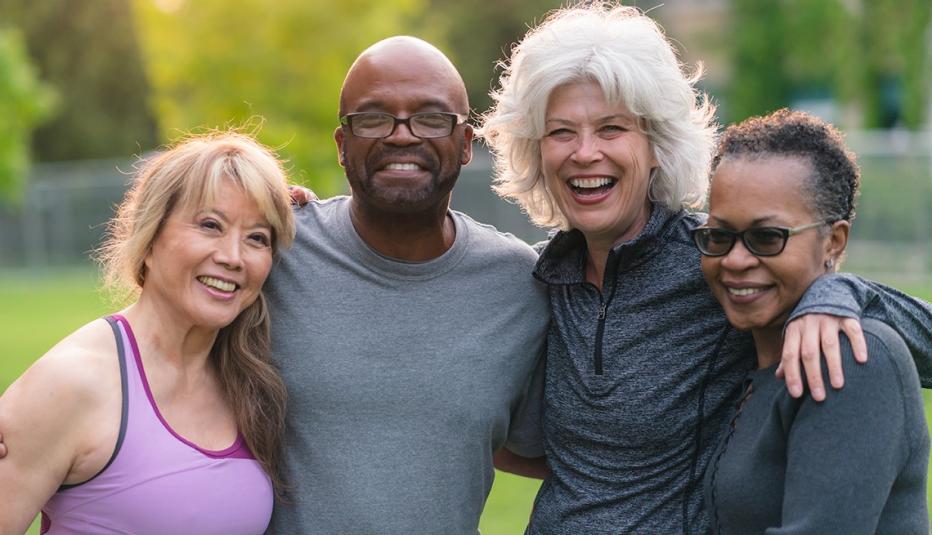Staying Fit
How Americans from different backgrounds describe their own health and access to medical care reveals differences depending on income, gender, and age, according to a new AARP national survey.


While 74% of adults over age 40 say they are in good, very good, or excellent health, just 59% of those with annual household incomes of less than $30,000 feel the same. Most respondents indicate their own health has been unchanged over the past two years; those more likely to believe it has worsened are lower income (36%), women (29%), and those 70-plus (30%).
Health Habits in Pandemic Times
The phone survey of about 1,500 adults shows that the global pandemic has affected people’s health habits in different ways. About one-third of people say they are sleeping/napping, meditating, or praying more but also eating unhealthy or comfort foods more often. More than half of adults 40-plus say they are having difficulty falling or staying asleep, with near majorities experiencing feelings of depression or hopelessness.
Older Americans tried to stay active last fall, but the survey revealed notable differences among respondents. About two-thirds say they regularly exercised — 68% of men and 57% of women, 49% of lower income adults versus 75% of high-income Americans, and 45% of those in poor/fair health compared to 75% of adults in excellent or very good health.
What Kept People From Exercising?
Topping the list is lack of energy and fatigue, followed by health problems, bad weather, and lack of time. Among those under age 50, cost, work schedules, and not having a safe place to exercise are also factors; more of those over 60 worry about getting injured. Women more often cite feeling tired or having no one to exercise with as a barrier, while men tend to mention work schedules.
Stress and Mental Health
AARP polling discovered that adults 40-plus rated their mental health slightly higher than their overall health. As for stress, Americans are feeling it — but just how much depends on a variety of factors.
Overall, 27% of adults 40 and older report high stress. Those in their 40s were more likely (38%) to be highly stressed than those age 50–59 (33%) as well as those age 60–69 (18%) and those over 70 — only 13% of whom report high stress. More women (30%) than men (24%) report high stress.
The gap persists by income. High stress is common among 32% of adults at the low end of the income spectrum and 23% of those in the highest-income group (i.e., those earning more than $50,000 a year). Also, stress levels were roughly twice as high among those in poor health compared to those with excellent health (41% vs. 21%).
Most Americans 40-plus agree on the top factors in maintaining good health: getting enough sleep (89%), maintaining brain health (88%) and staying drug-free (86%). As people age, they tend to become more concerned about vision, cognition, hearing loss, and colorectal cancer, while depression concerns decrease as Americans get older.
Interacting With the Health Care System
When people seek medical attention, eight in 10 adults 40-plus have a “regular” doctor they rely on. Women, those who are more affluent, and those over 70 are more likely to have visited their health care provider recently, according to AARP. Frequent discussions center on immunizations, diet/weight, and exercise. Men were more likely than women to talk about smoking, brain health, alcohol use, and sexual health with their doctors.
The most common medical tests include blood pressure checks, eye exams, and cholesterol tests. For women over age 40, just 53% get regular mammograms, 44% have regular breast exams, and 37% go in for regular pap tests. One-third of men have had a screening for prostate cancer in the past two years, the survey shows.
AARP polling revealed a range in diagnosis and awareness of certain health conditions. The most common health problem for adults over 40 is high blood pressure (35%), followed by anxiety and arthritis (both 29%) and high cholesterol and depression (both 26%). Prevalence of health conditions declines with income.
Cost of Services Is a Factor When Seeking Care
While 32% of adults say they don’t fill prescriptions sometimes, often, or always because of cost, 38% limit medical care, and 46% limit trips to the dentist. Cost was a barrier more often for those age 40–59 and with incomes less than $50,000; there were no differences by gender on affordability of care.
Those most likely to skip filling a prescription are in their 40s — 67% of Americans in that age group indicate they are priced out of getting medications at least part of the time. That’s the case for only 17% of those over 70, who would be eligible for coverage with Medicare. Overall, about half of Americans 40-plus say cost is problematic, according to the AARP survey.
Methodology
This AARP research was based on a nationally representative 25-minute survey of 1,505 adults on land lines and cell phones between November 10 and 20, 2020. Data were weighted by age, gender, race/ethnicity and education.
For more information, contact Teresa A. Keenan, tkeenan@aarp.org. For media inquiries, contact media@aarp.org.































































